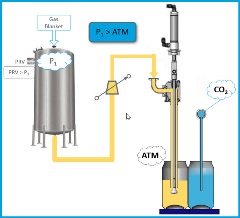Traditional open air or atmospheric filling, where the product flows from a filler manifold directly into an open can, is a common technology for craft brewing, and is offered by a variety of canning line suppliers. This method is cost-effective for still and lower-carbonation products and is relatively simple to operate and maintain, but it does have a few limitations to be aware of compared to counter-pressure filling. When choosing your filling method, consider that open air filling:
- Is intended for low speed, linear production, typically up to 100 CPM
- Creates foam as a natural part of the filling process
- Requires more attention to managing production variables (e.g., batch temperature, pressure, etc.) due to the open environment
- Is suitable for a more narrow range of products, based on carbonation level, temperature, and pressure, up to a threshold of 2.7 to 3.0 Vols of CO2.
Filling Basics
In open air filling, optimizing the process requires careful control of product temperature and pressure. Product line restriction is used to mitigate breakout from feed pressure (P1) to atmosphere. Sub-surface filling minimizes product agitation, and single can indexing prevents disturbing the product and altering CO2 values. The filling process follows these steps:
 1. The can is pre-loaded under the fill head
1. The can is pre-loaded under the fill head
2. Fill head descends into the can
3. CO2 is flushed and the can is filled
4. Fill head retracts as the can fills
5. Filling ends
6. Fill head fully retracts from the can
7. Can is indexed
8. Fill head descends into the next can and the process repeats